Visual Sources (Classics A-Level - OCR)
0.0(0)
0.0(0)
Card Sorting
1/13
Study Analytics
Name | Mastery | Learn | Test | Matching | Spaced |
|---|
No study sessions yet.
14 Terms
1
New cards
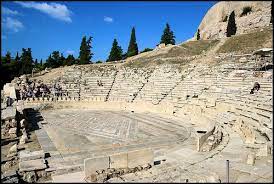
Theatre of Dionysus
Date - 2nd half of the 6th Century BCE
It was the main theatre of ancient Athens. However, not much of it survives. It has been determined that what remains of it was rebuilt by the Romans.
It was the main theatre of ancient Athens. However, not much of it survives. It has been determined that what remains of it was rebuilt by the Romans.
2
New cards
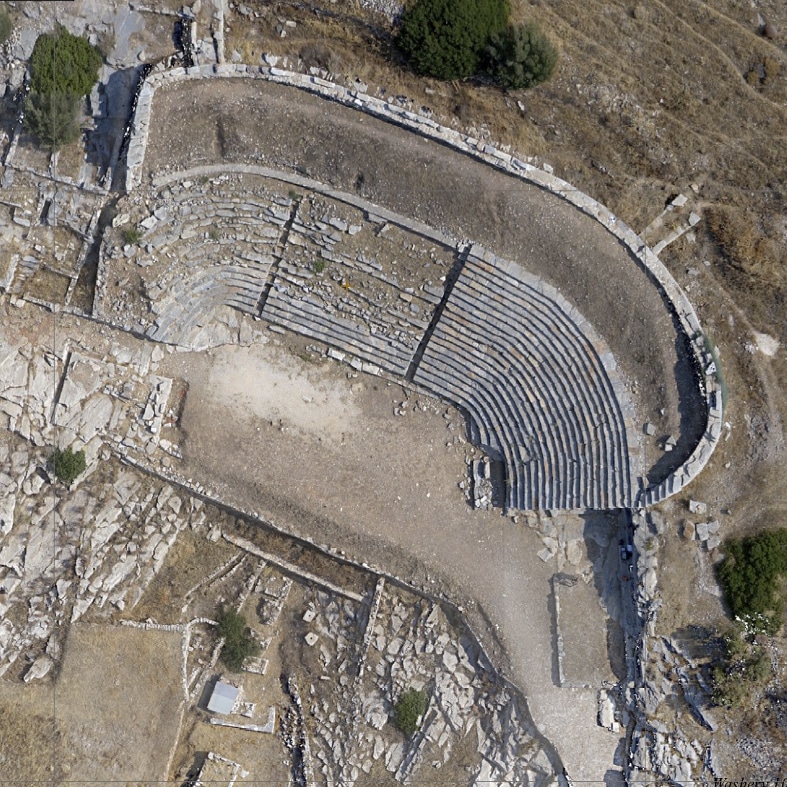
Theatre of Thorikos
Date - 5th Century BCE
There is not much left of Thorikos - it lacks a stage building in front of the orchestra and theatron. There was never a permanent stage building at this theatre. It does not provide information on the size and shape of the skene. It has a rectangular orchestra, although there is no consensus on the orchestra's shape during this period. It has a straight facing theatron with curved sides. Completely unline Dionysus and Epidauros.
There is not much left of Thorikos - it lacks a stage building in front of the orchestra and theatron. There was never a permanent stage building at this theatre. It does not provide information on the size and shape of the skene. It has a rectangular orchestra, although there is no consensus on the orchestra's shape during this period. It has a straight facing theatron with curved sides. Completely unline Dionysus and Epidauros.
3
New cards
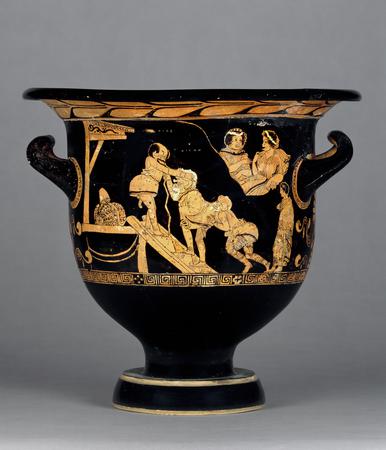
Bell Krater by McDaniel Painter - Cheiron Vase
Date - 380-70 BCE
A scene from an unknown comedy thought to be a parody of the myth where Cheiron is healed by Apollo. It illustrates the use of farce and slapstick in comedy. Xanthias (blondie) stands at the top of the steps and an actor in a more tragic outfit is thought to be Achilles. There is also a separate scene of two nymphs. It displays comic costuming and masks.
A scene from an unknown comedy thought to be a parody of the myth where Cheiron is healed by Apollo. It illustrates the use of farce and slapstick in comedy. Xanthias (blondie) stands at the top of the steps and an actor in a more tragic outfit is thought to be Achilles. There is also a separate scene of two nymphs. It displays comic costuming and masks.
4
New cards
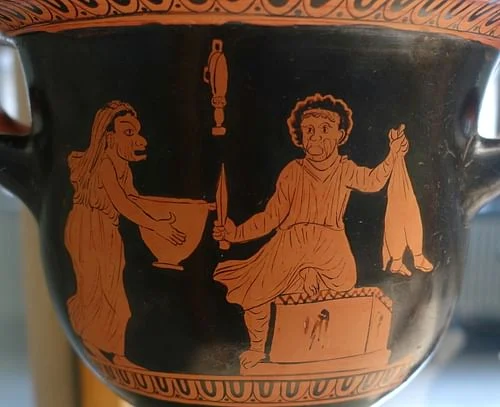
Red figure bell crater by Schiller Painter, Thesmophoriazusae Vase
Date - 380-70 BCE
A scene from Aristophanes's Thesmophoriazusae is depicted. It is a southern Italian vase suggesting the play was reperformed at least once in southern Italy. Comic outfits are depicted but the skene is not.
A scene from Aristophanes's Thesmophoriazusae is depicted. It is a southern Italian vase suggesting the play was reperformed at least once in southern Italy. Comic outfits are depicted but the skene is not.
5
New cards
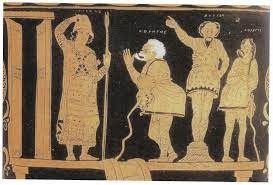
Comic Angels Vase
Date - 400-380 BCE
Painted in southern Italy, this vase shows a scene from an unknown comedy. The figures are labelled, the leftmost figure is 'Aegisthus', followed by 'Pyrrhias'. The other two figures are labelled as 'choregos'. These two figures were staples of their genres, suggesting a depiction of a comic competition between the two. The painter used artistic license to put the choregos on the stage. It shows the difference between comic and tragic costumes.
Painted in southern Italy, this vase shows a scene from an unknown comedy. The figures are labelled, the leftmost figure is 'Aegisthus', followed by 'Pyrrhias'. The other two figures are labelled as 'choregos'. These two figures were staples of their genres, suggesting a depiction of a comic competition between the two. The painter used artistic license to put the choregos on the stage. It shows the difference between comic and tragic costumes.
6
New cards
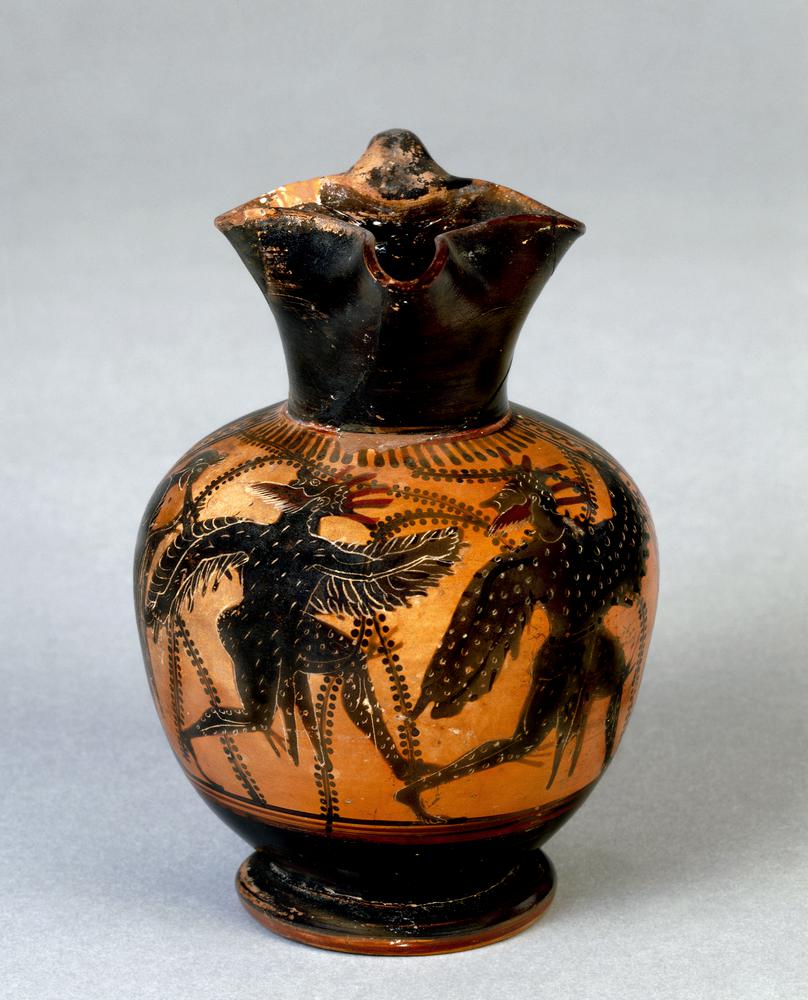
Black figure Birds Vase, depicting two chorus members
Date - 480 BCE
An auletes is depicted on the left - showing a theatrical or choral scene. The chorus members are dancing to the music. The vine branches are representative of Dionysus. It suggests that animal choruses existed before Aristophanes (Birds 414 BCE).
An auletes is depicted on the left - showing a theatrical or choral scene. The chorus members are dancing to the music. The vine branches are representative of Dionysus. It suggests that animal choruses existed before Aristophanes (Birds 414 BCE).
7
New cards
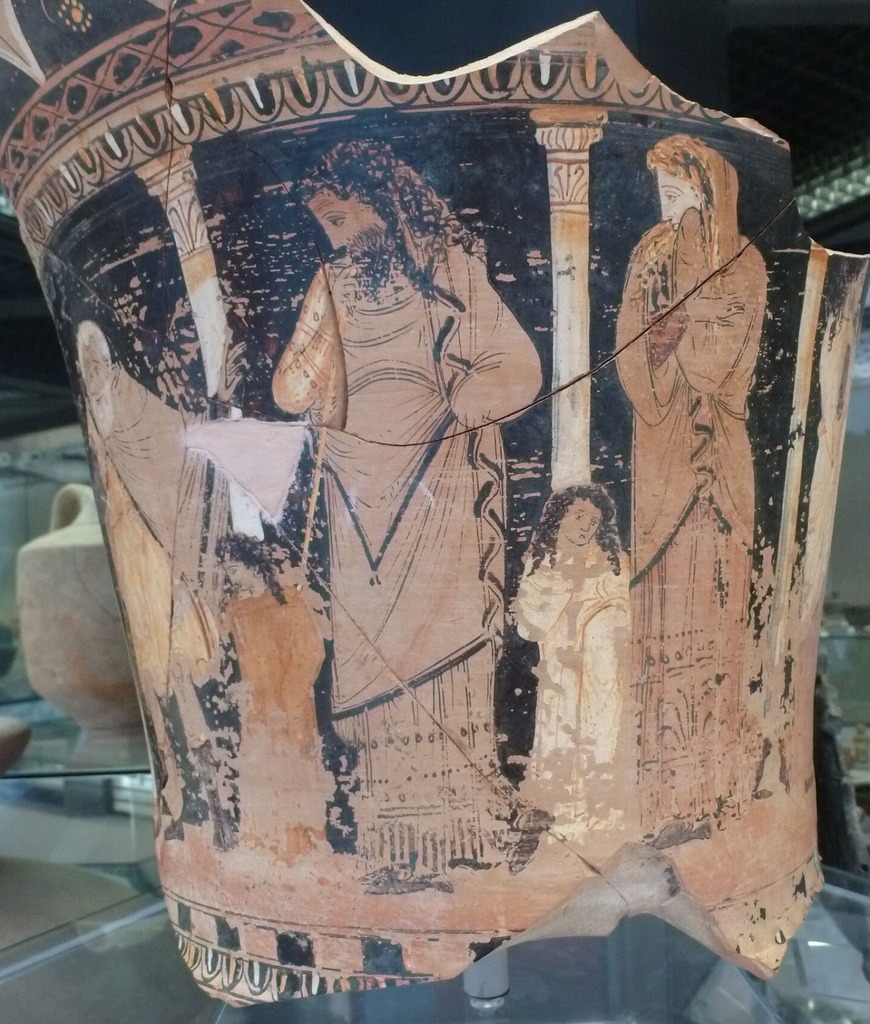
Calyx Krater by Capodarso painter, Oedipus the King Vase
Date - 330 BCE
Jocasta's expression is one of grief and worry. Oedipus appears puzzled. The Messenger faces the audience as he would in the play. The skene is ornate and depicts the castle. The vase is however damaged which limits its usefulness. Antigone and Ismene are on the stage, which is artistic license. Created over a century after the play was first performed.
Jocasta's expression is one of grief and worry. Oedipus appears puzzled. The Messenger faces the audience as he would in the play. The skene is ornate and depicts the castle. The vase is however damaged which limits its usefulness. Antigone and Ismene are on the stage, which is artistic license. Created over a century after the play was first performed.
8
New cards
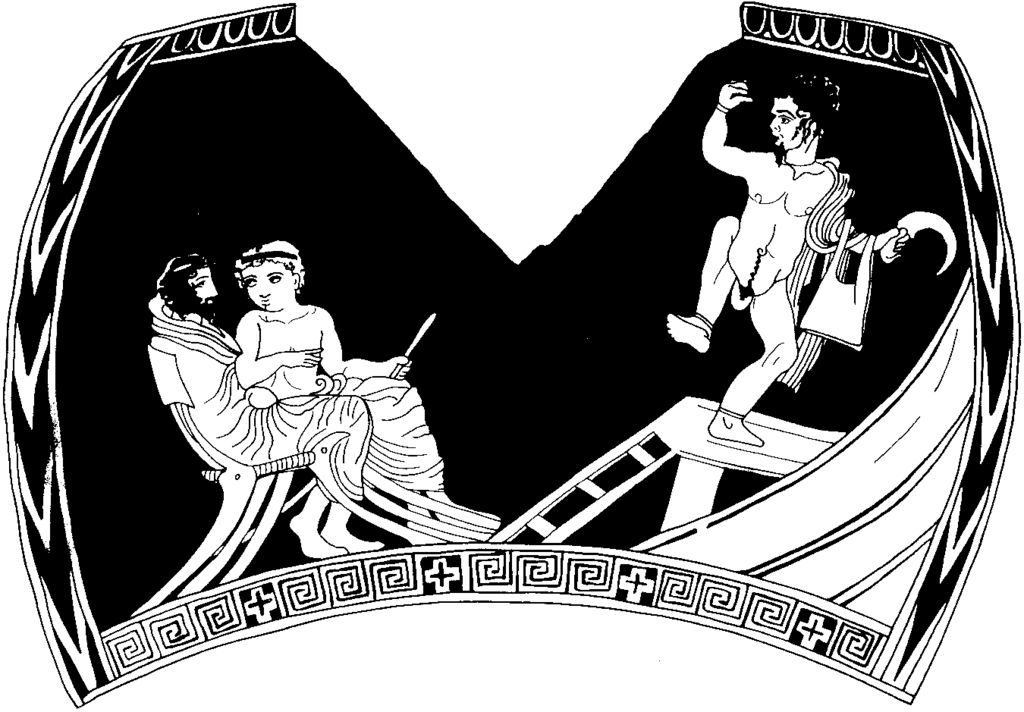
Red figure vase, Perseus and two audience members
Date - 420 BCE
This is the only surviving vase to depict audience members/judges. The drawing contains reconstructed pieces as it was heavily damaged. The figure appears to be Perseus holding Medusa's head in a bag and a sickle. He may be dancing or pretending to be flying. There is no orchestra or chorus depicted. It is unclear if both audience members are men, or one is a woman, or priests of Dionysus, or Dionysus himself and Ariadne, or the choregos and playwright.
This is the only surviving vase to depict audience members/judges. The drawing contains reconstructed pieces as it was heavily damaged. The figure appears to be Perseus holding Medusa's head in a bag and a sickle. He may be dancing or pretending to be flying. There is no orchestra or chorus depicted. It is unclear if both audience members are men, or one is a woman, or priests of Dionysus, or Dionysus himself and Ariadne, or the choregos and playwright.
9
New cards
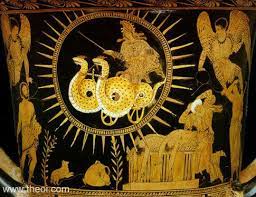
Red figure Calyx Krater depicting Medea's escape
Date - 400 BCE
Potential depiction of the use of the crane and the wheel platform. However, not necessarily depicts everything that occurred on stage,
Potential depiction of the use of the crane and the wheel platform. However, not necessarily depicts everything that occurred on stage,
10
New cards
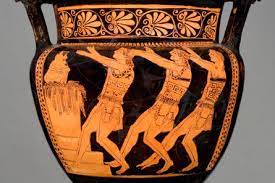
Red figure column krater, Basel Dancers Vase
Date - 500-490 BCE
The painting depicts a tragic chorus in action. The chorus turns towards either a priest or a statue of Dionysus on an altar in the orchestra. Six men move in unison in identical costumes and masks. However, we don't know what they're singing/saying/performing. Only 6 out of up to 15 chorus members for tragedy during this period are depicted.
The painting depicts a tragic chorus in action. The chorus turns towards either a priest or a statue of Dionysus on an altar in the orchestra. Six men move in unison in identical costumes and masks. However, we don't know what they're singing/saying/performing. Only 6 out of up to 15 chorus members for tragedy during this period are depicted.
11
New cards
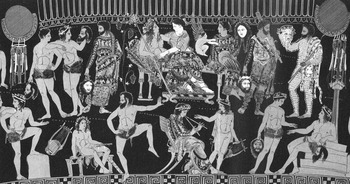
Volute krater by the Pronomos Painter, depicting a team of actors, an aulos player, a playwright and Dionysus
Date - 410 BCE
The vase is southern Italian, depicting actors getting ready for a satyr play. Actors are dressed in tragic and satyric costuming and masks. It does not depict comic costuming or masks. There is an allusion to Heracles on the right, and Dionysus and Ariadne sit together in the centre - perhaps suggesting how mythical figures were often included in the plays.
The vase is southern Italian, depicting actors getting ready for a satyr play. Actors are dressed in tragic and satyric costuming and masks. It does not depict comic costuming or masks. There is an allusion to Heracles on the right, and Dionysus and Ariadne sit together in the centre - perhaps suggesting how mythical figures were often included in the plays.
12
New cards
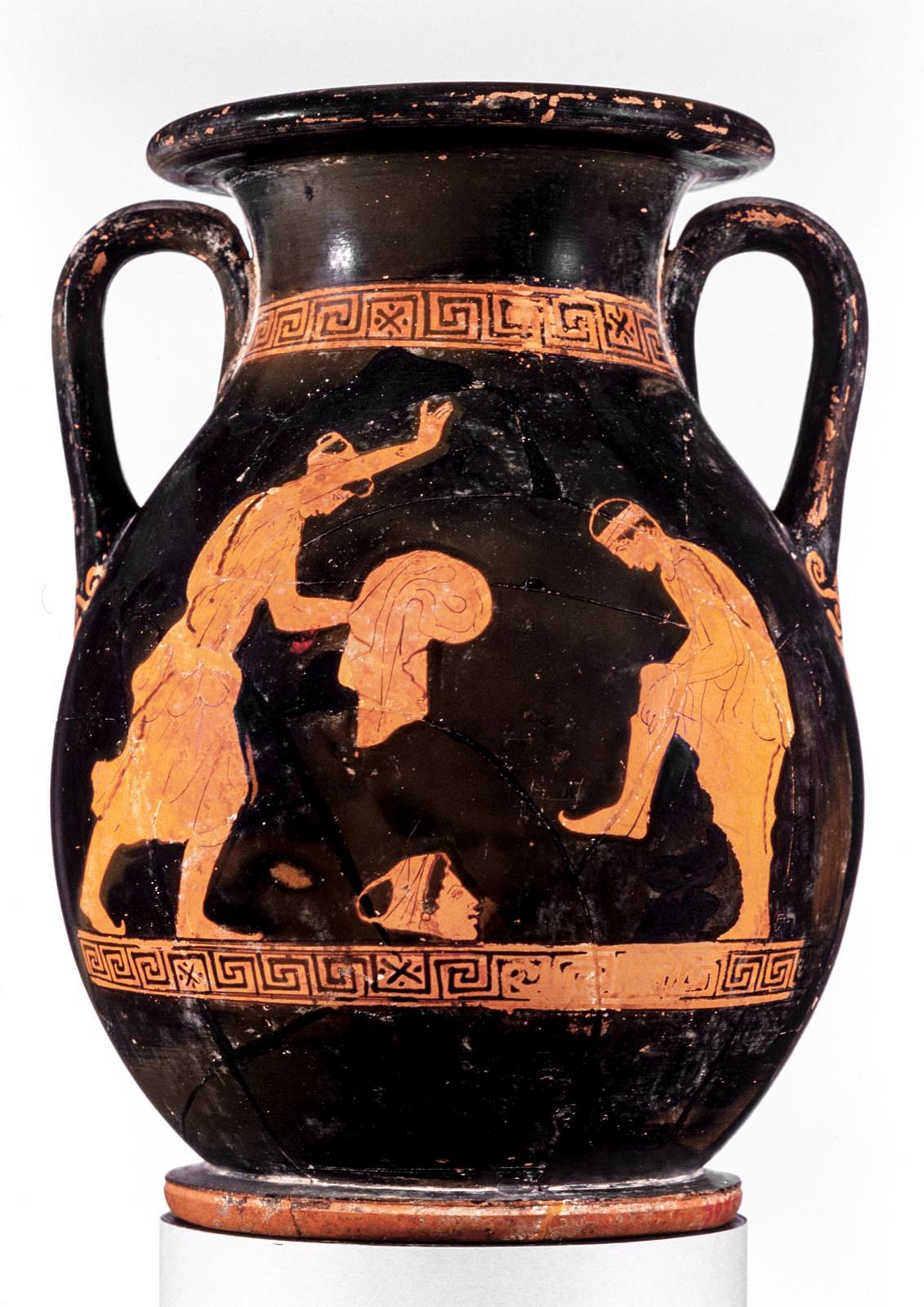
Pelike by Phiale Painter depicting tragic actors dressing
Date - 450 BCE
The painting shows two tragic actors getting into costume. Boots for tragic actors had thin soles and turned up toes to allow them to move about more easily. Both actors are dressing up as women.
The painting shows two tragic actors getting into costume. Boots for tragic actors had thin soles and turned up toes to allow them to move about more easily. Both actors are dressing up as women.
13
New cards

Red figure stamnos by Dinos Painter, Maenad
Date - late 5th century BCE
Portrayal of a Dionysian festival by maenads. Suggests that there was a lack of modesty or less strict rules for women who worshipped Dionysus. It depicts a statue of Dionysus in the centre. There are no actors or a stage depicted in the image.
Portrayal of a Dionysian festival by maenads. Suggests that there was a lack of modesty or less strict rules for women who worshipped Dionysus. It depicts a statue of Dionysus in the centre. There are no actors or a stage depicted in the image.
14
New cards
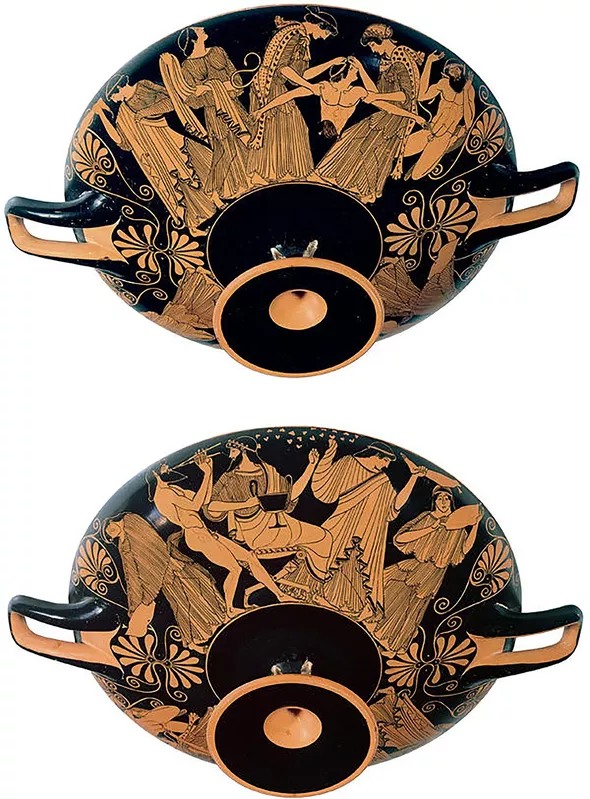
Red figure kylix by Douris painter, The Death of Pentheus
Date - 480 BCE
A depiction of Pentheus's death that pre-dates Euripides' Bacchae. The mythological depiction of his death closely matches the version thought up by Euripides.
A depiction of Pentheus's death that pre-dates Euripides' Bacchae. The mythological depiction of his death closely matches the version thought up by Euripides.